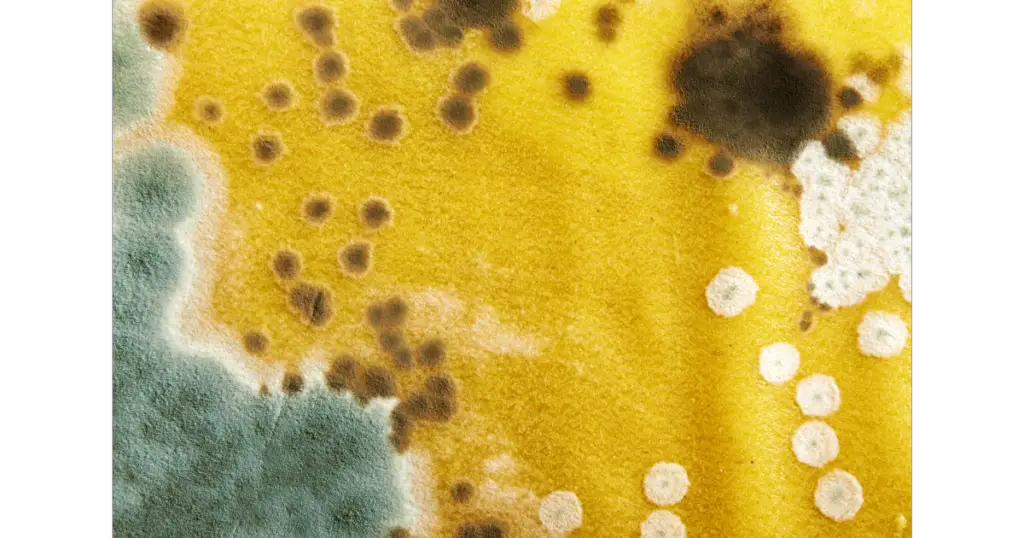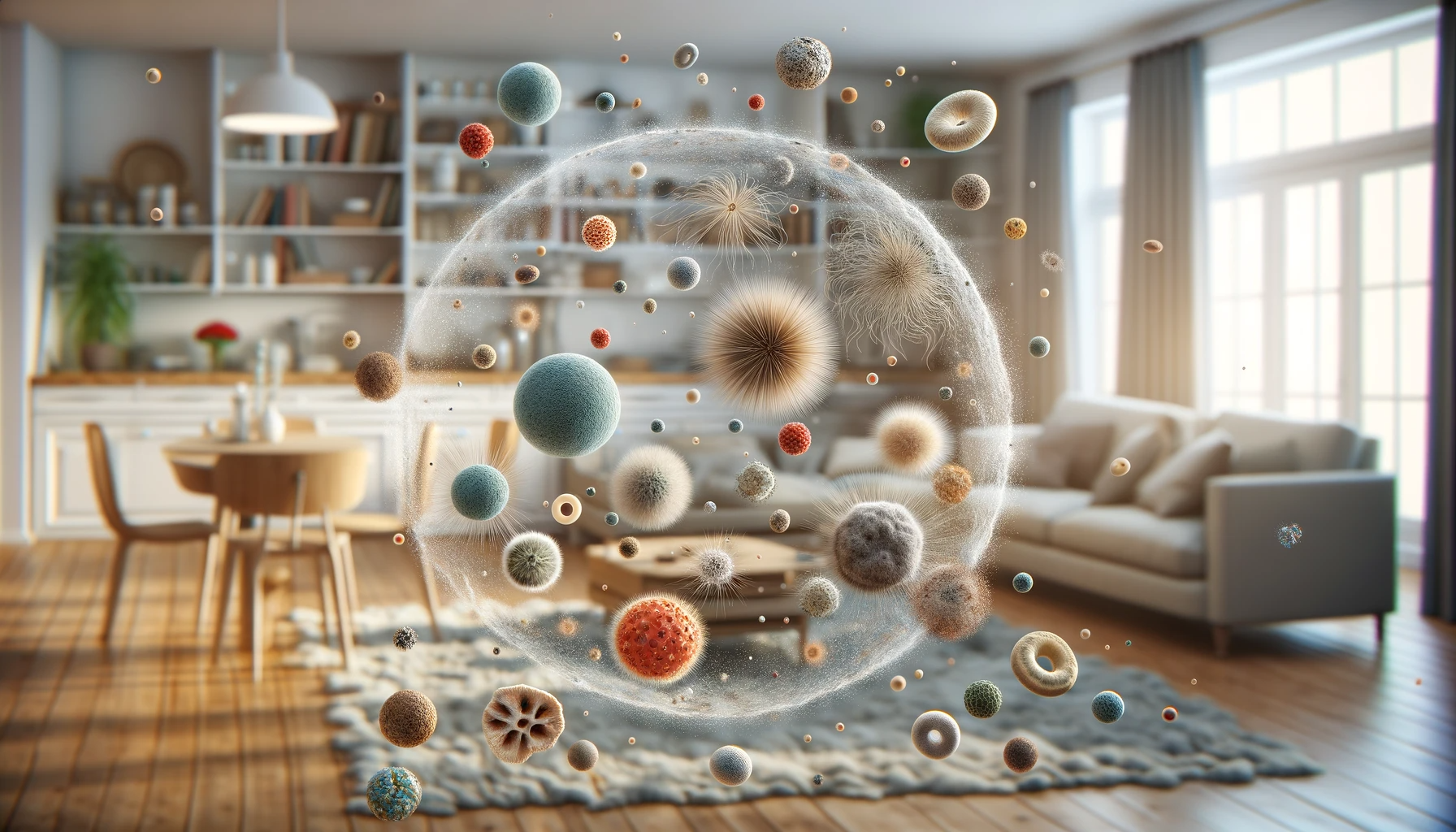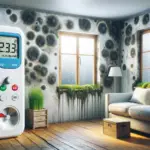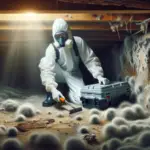The short answer is yes. Mold spores can be found in the air, on surfaces, and even inside our homes. Unfortunately, mold spores are hard to avoid since they are so tiny and so common.
In this article, we will provide you with an extensive knowledge base about mold and all its intricacies. With our assistance, you can easily gain a comprehensive understanding of the complexities surrounding this fascinating organism.

What is Mold?
Mold is not an animal nor a plant, it is a species of the Fungi kingdom that includes mushrooms and yeasts, they are one of the most abundant organisms on earth with more than 144,000 identified varieties. Not only do they help break down organic materials like fallen leaves or dead trees in nature’s cycle; but surprisingly enough, some molds also live non-destructively within our homes – though you should still take caution to be aware if mold levels become too high!
From cheeses and cured meats to fermented soybeans, many of the foods we eat owe their deliciousness to mold. Not only do molds provide us with scrumptious treats but also play essential roles in biotechnology, food science and other processes such as producing beverages, enzymes and pharmaceuticals.
What Are The Most Common Types Of Mold?
The most common types of indoor molds are Aspergillus, Penicillium, Alternaria, Penicillium, Stachybotrys chartarum (black mold) and Cladosporium. These types of mold can be found in warm and damp environments such as bathrooms, kitchens, basements and air conditioning systems.
- Aspergillus is usually found in air, soil and decaying vegetation and is easily recognizable by its small black spores.
- Alternaria is a type of fungus commonly found outdoors but can also be found indoors on damp surfaces.
- Cladosporium tends to grow on fabrics and other organic materials, such as wood or paper. Penicillium has a wide range of colors, from blue-green to gray or white and can be found in carpets and wallpaper.
- Stachybotrys chartarum (black mold) is one of the more dangerous molds, as it has been linked to adverse health effects such as respiratory problems, headaches and fatigue. It is usually found in areas with water damage or high humidity such as attics, basements or bathrooms.
All these molds can produce toxins that can lead to respiratory conditions when inhaled so it’s important to take steps to prevent their growth.
What are mold spores and where to find them?
Mold spores are tiny particles that act as fertilizers for the growth of molds. They range in size from 1 to 50 microns, with some larger species measuring up to 100 microns. Most mold spores are spherical or egg-shaped, and they can be found in air, soil, water, and decaying vegetation and can be carried by wind or moisture. They are also commonly found living in damp and moist areas in your home such as:
- Bathrooms
- Basements
- Crawlspaces
- Attic
- Walls
- Laundry rooms
- Kitchen
High levels of mold spores can be released into the air if heavily infested areas are disturbed or if humidity levels become too high. In addition to being found naturally in the environment, mold spores can also spread through inadequate ventilation or contact with contaminated materials like building materials, furniture, or clothing.
Inhaling mold spores can lead to a variety of respiratory problems like asthma and hypersensitivity pneumonitis.
What Do I Need to Know About Mold Growth?
Mold is a type of fungus that thrives in damp and humid places. It starts as very small spores that, if exposed to the right conditions, can quickly grow into colonies of visible mold. Moisture is key to mold growth; when it’s present in dark and warm areas, mold spores thrive and stay in the environment for a long time.
Depending on the type of mold, they can colonize different surfaces like walls or other organic materials such as furniture or clothes. Exposure to mold spores can be dangerous to humans, leading to allergies and other health problems.
Indoor Mold Growth – How it gets inside my house?
Mold can get inside of your home in a few different ways. The most common way is through air infiltration when spores are drawn into the house through small cracks or unsealed vents and windows. These spores settle on various surfaces and begin to grow if they have access to moisture.
Furthermore, mold spores can easily enter your home via clothing, furniture or building materials that were previously exposed to a moist setting and became contaminated.
It’s important to take steps to reduce the risk of mold growth in your home by maintaining adequate ventilation and reducing indoor humidity levels. This will help prevent mold from colonizing inside of your home and causing allergic reactions and health problems.
Outdoor Mold Growth – Where can I find it?
Outdoor mold growth is a common problem in many places around the world. Mold spores can grow in soil, concrete, and other places outside of the home including decks, patios, and playgrounds. In these areas, they usually find moisture from rain, dew or condensation.
Once the area becomes moist, mold spores will attach to it and begin to reproduce. If there is enough water present, then the mold spores will form colonies that break down and decompose organic materials such as wood and plants. Aside from being unsightly, outdoor mold growth can also lead to respiratory problems if inhaled.
High humidity levels can also cause outdoor mold growth, especially during the summer months when there’s more water vapor in the air. Outdoor mold can easily infiltrate indoor spaces if not treated, so it’s important to take steps to prevent its growth and spread.
How Long Do Mold Spores Stay Active?
Mold spores can remain active in the environment for up to two years, depending on the type of mold and environmental conditions. In dry environments, they may only last a few weeks or months before diminishing. However, when moisture levels are high or there is food or organic material present, then mold spores can stay active for much longer.
If you fear that your home is infected with mold spores, it’s critical to have a professional inspect the affected area so they can precisely determine which kind of mold is present. Following this identification, action must be taken promptly to either eradicate or decrease the quantity of mold to protect those living inside from potential health risks.
Is it possible to get rid of mold spores?
Unfortunately, the answer is no. Spores are too minuscule to be seen with the naked eye and can linger in the air for an extended period. Even a slight breeze can distribute them across long distances and into residences or buildings without difficulty. Furthermore, you can take a few crucial steps to help reduce or even eradicate mold spores from within your home.
Health Problems Related to Mold Exposure
Mold exposure can cause a wide variety of health problems, including asthma exacerbations, respiratory infections, and even some neurological conditions. Allergic reactions include symptoms such as coughing, wheezing, sneezing, watery eyes and throat irritation. Long-term or severe exposure can lead to more serious issues like pneumonia or difficulty breathing.
How to Prevent Mold Growth?
Mold spores can be prevented through mold remediation, which involves identifying the source and type of mold, cleaning affected surfaces with special cleaning products, and sealing or encapsulating any remaining mold colonies to prevent future growth.
The first step is to identify and address any moisture sources that can potentially encourage mold growth. This includes identifying water leaks, repairing windows and doors, checking rooms, basement, air conditioning drip pans, attic and crawling space.
- Fixing leaks and moisture sources is the first line of defense in preventing mold growth, the key to mold prevention is moisture control. Even small amounts of moisture can allow mold spores to germinate and take root in your home.
- Dehumidifiers can be particularly helpful for reducing the chances of mold spores taking root in your home. They help to remove moisture from the air, thereby eliminating a primary food source for mold growth.
- Air Purifiers and Air Cleaners are essential for purifying the air in your home from hazardous pollutants, such as mold spores. In essence, they function by sucking in the air which passes through multiple filters built to capture tiny particles before discharging purified air back into your living space. From HEPA Mechanical Air Filters to Ozone Generators, multiple types of air purifiers and cleaners are available for you to choose from. Electronic Air Filters such as Ionizers, Gas-Phase filters like Activated Carbon, and UVGI (Ultraviolet Germicidal Irradiation) Cleaners all offer unique solutions that work wonders in keeping the air pure inside your home or office space.
- Improving airflow and ventilation are both essential preventive steps for reducing the chances of mold growth. If anything is blocking or obstructing air flow inside your home, like furniture or drapery, then remove it as this will significantly decrease the chances of mold spores taking hold. Also, use fans to direct airflow in and out of rooms, particularly during hot and humid weather. This will help maintain a consistent level of ventilation throughout your home and assist in the prevention of mold growth.
- Clean surfaces with natural cleaners that may have been exposed to mold spores. Natural cleaning solutions such as baking soda, vinegar, hydrogen peroxide, tea tree oil, and essential oils can be used to prevent mold to grow.
Knowing how to protect your home from mold is key. Utilize the right knowledge and techniques, as well as the correct tools, and you’ll be able to safeguard your household against any unwelcome fungus growth – ultimately saving you time and money in costly repairs down the road.
Mold Testing
The best way to test for mold spores is to have a professional inspect the affected area. A professional inspector can accurately determine what type of mold spore is present and its severity and provide recommendations on how to eradicate or reduce it.
Additionally, they may also examine your property and suggest preventive measures to control mold growth to further reduce the chance of problems in the future.
If you are unable to have a professional inspect your property, there are DIY testing kits available that can help you identify if mold spores are present in your home or office. These kits typically involve air samples that require analysis by a laboratory for conclusive results.
Professional Help
Many companies specialize in this field if you’re looking for professional help with mold prevention and remediation.
These experts can guide the best possible solutions to prevent and rid your home of any unwanted fungal growth – from consultation and assessment to full-service removal and restoration.



